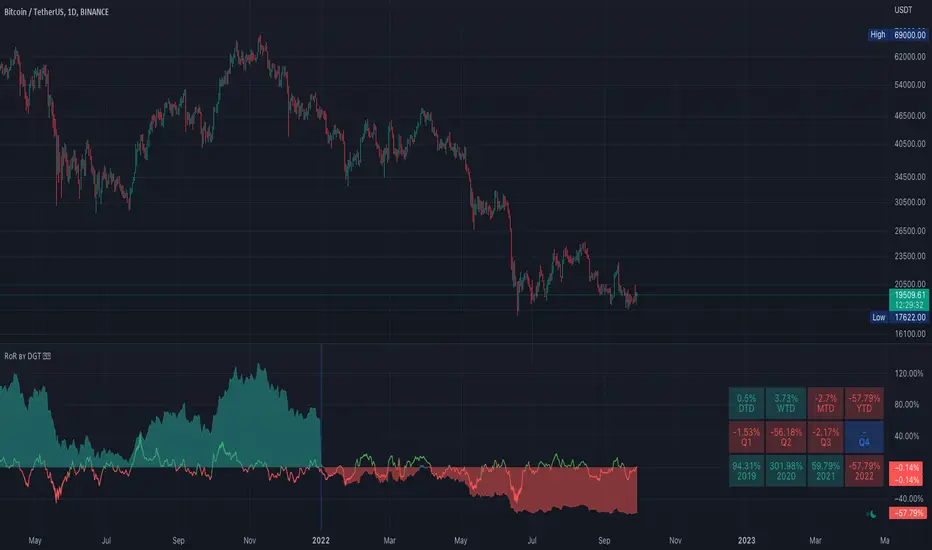OPEN-SOURCE SCRIPT
Zaktualizowano Rate of Return (RoR) by DGT

A rate of return (RoR) is the net gain or loss of an investment over a specified time period, expressed as a percentage of the investment’s initial cost
Informacje o Wersji
Display format updated as percentages since we measure changes in percentage with this study Informacje o Wersji
Rate of Return (RoR) also called Return on Investment (ROI) is a performance measure used to evaluate the efficiency of an investment, net gain or loss of an investment over a specified time period, he rate of change in price movement over a period of time to help investors determine the strength of a trendThis study measures monthly, annual and custom length of rate of return
In the previous version, annual and monthly calculations was suitable for crypto market and daily time frame only. Thanks to spetry who find out the issue and warned me
now updated to cover other markets and will be shown for daily timeframe only
Custom length RoR will be calculated in all time frames for all markets.
Reminder: RoR provides identical figures with momentum indicator, only values expressed in percentage
Informacje o Wersji
This update introduces an experimental application of feedback concept common in Electronic Engineering, attempting to present additional value/insight to the Indicator Rate of Return. RoR, as explained above is a measure of net gain/loss of an financial instrument over a specified period of time, also sometimes called the basic growth rate, or alternatively, return on investment (ROI). Mathematically you may consider RoR same as a Momentum (MOM) or Rate of Change (ROC) Indicator and benefit from their trading concepts.Feedback concept in Electronic Engineering
Negative feedback (or balancing feedback) is applied to reduce the fluctuations, whether caused by changes in the source or by other disturbances. The applied negative feedback can improve performance, gain stability, linearity and reduce sensitivity to parameter variations due to environment.
Whereas positive feedback tends to lead to instability via exponential growth, oscillation or chaotic behaviour
observations of applying feedback effect :
-emphasis the sudden large price movements
-emphasis the probable reversal or corrections points of momentum
-emphasis stability periods - no affects observed during average prices movements (both direction), rate of return with feedback effect remain almost same as rate of return
Sensitivity can be adjusted with feedback factor provided as user argument, monthly and annual plotting does not benefit from feedback factor
mathematical expression and formulation of feedback effect
our formula of the rate of return is expressed as
rate-of-return = (current value - initial value) / initial value
alternatively, rate-of-return can be expressed by current value / initial value
In Pine,
rate-of-return = source / source(length)
Let’s apply a negative feedback as in electronic engineering concept, just it would be easy to consider the negative feedback in trading as brokerage commission or the effect of inflation over time which are not taken into consideration of simple rate of return calculation
rewriting the formula as:
rate-of-return * source(length) = source
adding negative feedback by subtracts a fraction of current source value from initial source value, we can express
rate-of-return * (source(length) - feedback-factor * source) = source
where feedback-factor is the feedback fraction (with this study value from 0 to 1)
rate-of-return * source(length) - feedback-factor * source * rate-of-return = source
rate-of-return * source(length) = source * ( 1 + feedback-factor * rate-of-return )
the rate-of-return with negative feedback effect becomes
rate-of-return-negative-feedback = source / source(length) = rate-of-return / ( 1 + feedback-factor * rate-of-return )
similarly, positive feedback is adding fraction of current source value to initial source value, which results as
rate-of-return-positive-feedback = rate-of-return / ( 1 - feedback * rate-of-return )
Trading success is all about following your trading strategy and the indicators should fit within your trading strategy, and not to be traded upon solely
Disclaimer: The script is for informational and educational purposes only. Use of the script does not constitute professional and/or financial advice. You alone have the sole responsibility of evaluating the script output and risks associated with the use of the script. In exchange for using the script, you agree not to hold dgtrd TradingView user liable for any possible claim for damages arising from any decision you make based on use of the script
Informacje o Wersji
update :* presentation improvements, input option tooltips
* smoothing line addition
* Pine v5 update
ps : positive feedback effect removed, plottings are adjusted to rate of return and the negative balancing feedback effect
Informacje o Wersji
update : added * to date RoR plotting options
* performance table option
Skrypt open-source
W zgodzie z duchem TradingView twórca tego skryptu udostępnił go jako open-source, aby użytkownicy mogli przejrzeć i zweryfikować jego działanie. Ukłony dla autora. Korzystanie jest bezpłatne, jednak ponowna publikacja kodu podlega naszym Zasadom serwisu.
Premium Indicators – Try Free for 15 Days: sites.google.com/view/solemare-analytics
Wyłączenie odpowiedzialności
Informacje i publikacje nie stanowią i nie powinny być traktowane jako porady finansowe, inwestycyjne, tradingowe ani jakiekolwiek inne rekomendacje dostarczane lub zatwierdzone przez TradingView. Więcej informacji znajduje się w Warunkach użytkowania.
Skrypt open-source
W zgodzie z duchem TradingView twórca tego skryptu udostępnił go jako open-source, aby użytkownicy mogli przejrzeć i zweryfikować jego działanie. Ukłony dla autora. Korzystanie jest bezpłatne, jednak ponowna publikacja kodu podlega naszym Zasadom serwisu.
Premium Indicators – Try Free for 15 Days: sites.google.com/view/solemare-analytics
Wyłączenie odpowiedzialności
Informacje i publikacje nie stanowią i nie powinny być traktowane jako porady finansowe, inwestycyjne, tradingowe ani jakiekolwiek inne rekomendacje dostarczane lub zatwierdzone przez TradingView. Więcej informacji znajduje się w Warunkach użytkowania.